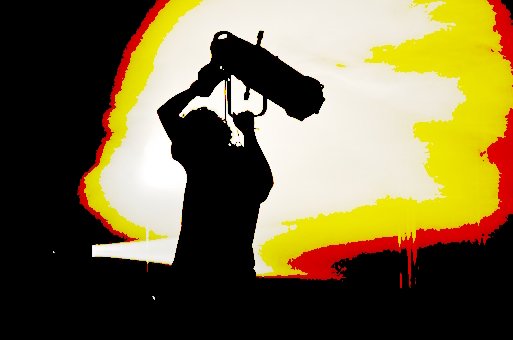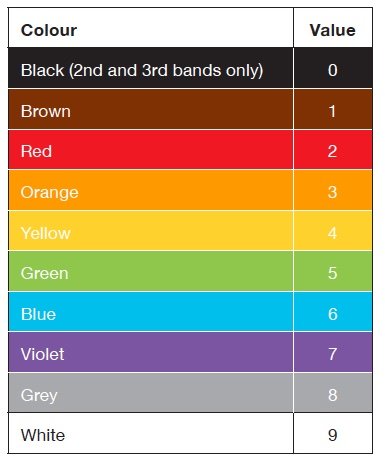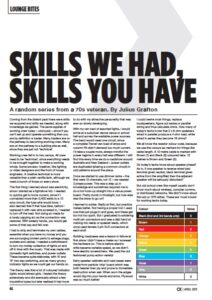News
19 Apr 2019
Skills We Had, Skills You Have

Subscribe to CX E-News
LOUNGE BITES
Skills We Had, Skills You Have
A random series from a 70s veteran
by Julius Grafton.
Coming from the distant past there were skills we acquired and skills we needed, along with knowledge we gained. The same applies of working crew today – obviously – since if you can’t set up and operate something then you are by definition a loader.
Many loaders are on the pathway to becoming working crew. Many are on the pathway to a building site as well, since they are just not ‘technical’. Working crew fall in to two camps. All crew need to be ‘technical’, since everything needs to be brought together to make a working whole. Some are also ‘creative’, like lighting or video designers and like front of house engineers.
A creative technical is more valuable than a plain vanilla tech, although we need a bunch of those on every show.
The first thing I learned about was electricity, since I started as a lightshow kid. I needed to quickly get to know current, since if I connected more than 2,400 watts to a 10 amp circuit, the fuse wire would blow.
I also learned that if that fuse blew, before I replaced it with new wire screwed in, I needed to turn off the load. Not doing so made for a lovely zapping arc as the connection was restored. With sweaty hands, you would get some of that zap and fall over.
I had to strip and terminate my own cables, essential when you have no money and you are scrounging broken parts to salvage plugs, sockets and cables. I needed a switchboard to turn my motley collection of lights on and off in time with the music. That was made with domestic light switches, and power outlets. These became quite elaborate, with ‘A’ and ‘B’ two way switching, and as many groovy indicator lights as we could get our hands on.
The theory was that a lot of coloured indicator lights would attract girls. I tested the theory extensively and did eventually attract a few inquisitive types but later realised it had more to do with my attractive personality that was ever so slowly developing.
With my van load of assorted lights, I would arrive at a suburban dance venue or school hall and survey the available power sources. The band would need one circuit, since a complete Transit van load of amps and column PA didn’t demand too much current. I’d take a couple more, always mindful the power regime in every hall was different.
I still find this every time we do a roadshow around Australia and New Zealand – power outlets are duplicated (sharing a common circuit) in odd patterns around the place.
Once we started to use dimmer racks – the first were 10 channels, not 12 – we needed 3 phase power. This was a step up in knowledge and sometimes required me to do a hot hook-up straight into a venue power board. Pretty dumb in hindsight, but how else was the show to go on?
I learned to solder. Badly at first, but practice makes better. Not having a proper iron I used one that just plugs in and goes, and these get too hot too quick. But I graduated to soldering multi-pin connectors and was a dab hand at making mic leads or speaker leads, which once used female 3 pin XLR connectors at each end!
Building roadcases was a lesson in failure at first since I didn’t have a riveter so I screwed the hardware on. This is before electric drills became variable speed, so we didn’t have electric screwdrivers. We used the old fashioned pump action variety! Early speaker cabinets and road cases were made from particle ‘chip’ board which was both heavier than ply and prone to immediate destruction when wet. When worn the edges would dig into your hands and arms. Plywood was so much better!
I could rewire most things, replace loudspeakers, figure out series or parallel wiring and thus calculate ohms. How many of today’s techs know that 2 x 8 ohm speakers wired in parallel produce a 4 ohm load, while wired in series they become 16 ohms?
We all know the resistor colour code, because we use the colours as markers for things like cable length. A 10 metre cable is marked with Brown (1) and Black (0) coloured tabs. 15 metres is Brown and Green (5).
Do today’s techs know about speaker phase? As in, if one speaker is reverse wired (red terminal given neutral, black terminal given active from the amplifier) then the adjacent speaker will be seriously disturbed? But old school crew like myself usually don’t know much about wireless, complex comms, or distributed networks. We didn’t know about first aid or CPR either. These are ‘must knows’ for working techs today.
From CX Magazine – April 2019
CX Magazine is Australia and New Zealand’s only publication dedicated to entertainment technology news and issues – available in print and online. Read all editions for free or search our archive www.cxnetwork.com.au
© CX Media
Check out the History tab at the top of this CX page for more history of Aus lighting and sound
And this piece by Grahame Harrison, Colin Baldwin and Julius Grafton:
30 Years of Lighting and Sound in Australia [opens to a new site].
Subscribe
Published monthly since 1991, our famous AV industry magazine is free for download or pay for print. Subscribers also receive CX News, our free weekly email with the latest industry news and jobs.








